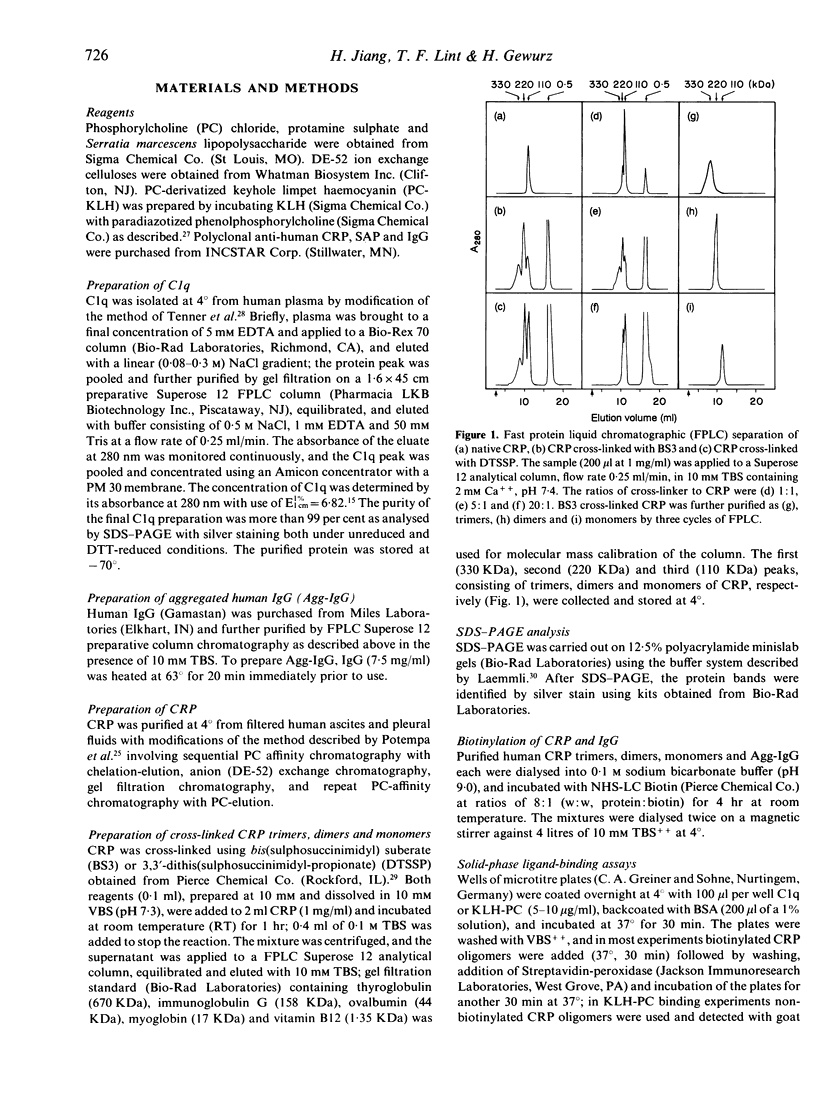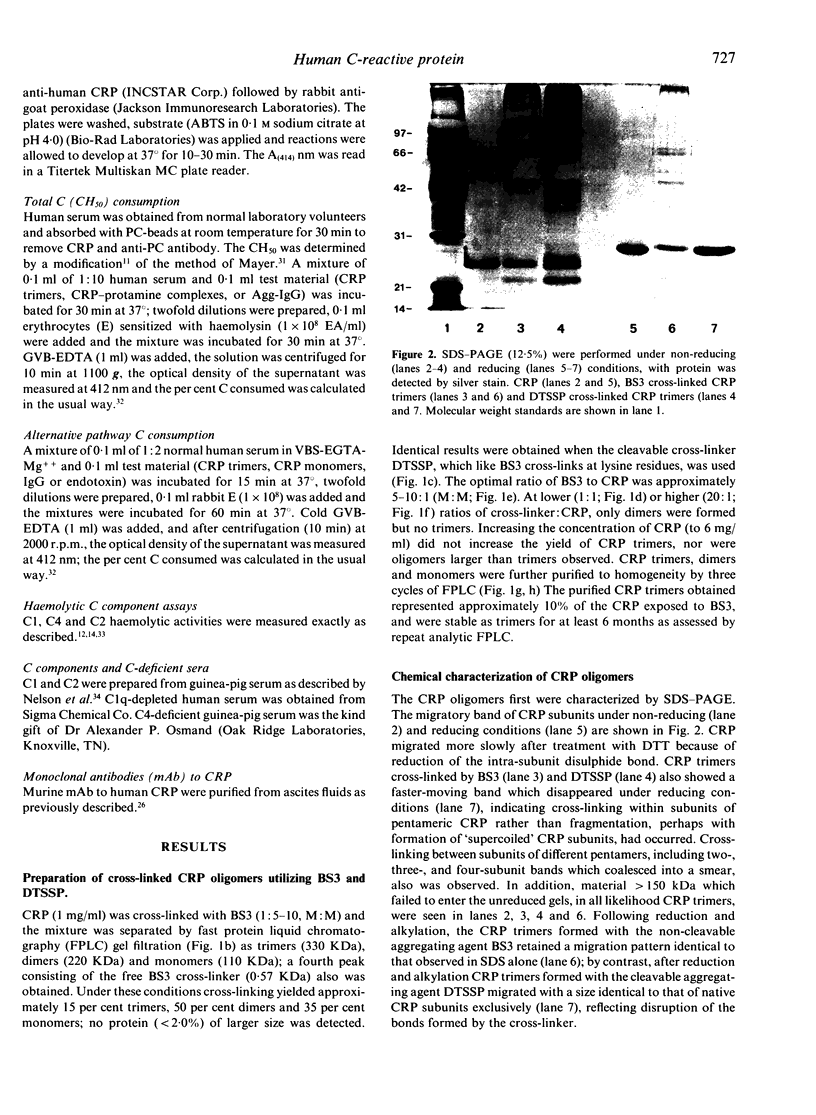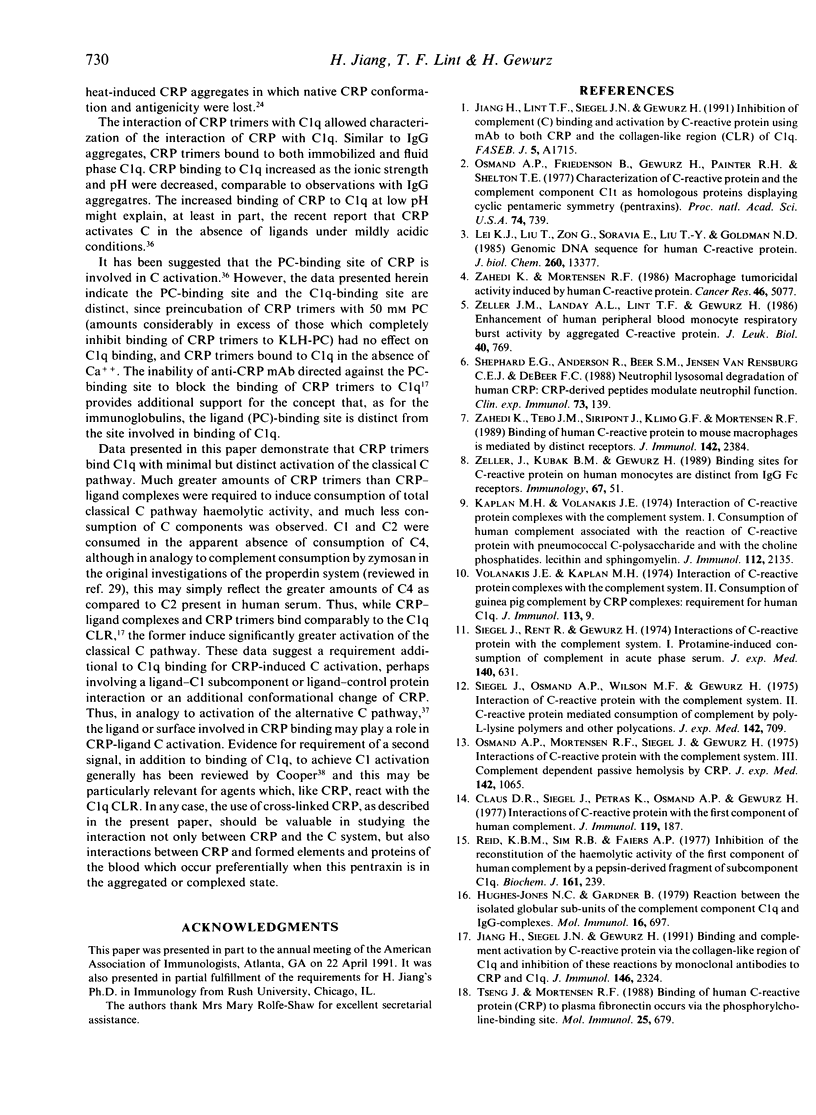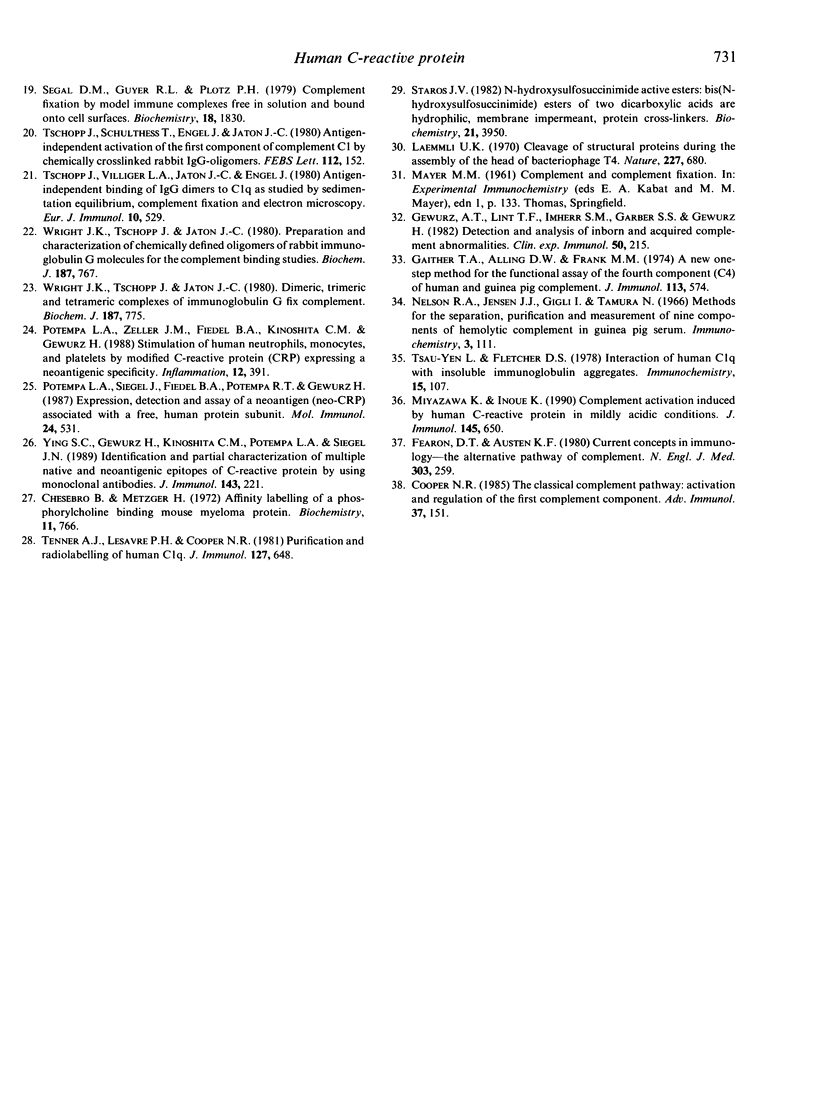Abstract
Chemically cross-linked C-reactive protein (CRP) oligomers were prepared and characterized, and C1q binding and C activation were investigated. Purified human CRP was polymerized in the presence of both non-cleavable and cleavable cross-linking agents and further separated by Superose 12 analytical FPLC column chromatography into fractions of 110 KDa (pentameric monomers), 220 KDa (dimers) and 330 KDa (trimers); virtually no larger oligomers were formed under a variety of experimental conditions. CRP subunits were cross-linked both within and between CRP pentamers. CRP trimers retained native CRP antigenicity without expression of neo-CRP epitopes. CRP trimers showed maximal binding and CRP dimers showed partial binding of solid phase C1q while CRP monomers bound virtually no C1q at all; CRP trimers also bound to fluid phase C1q. Binding was Ca++ independent and increased as the ionic strength or pH were lowered, characteristics comparable to binding of aggregated IgG to C1q; it was not inhibited by phosphorylcholine. CRP trimers consumed total C, C1 and C2 haemolytic activities upon incubation in fresh human serum, but much less efficiently than did CRP-protamine complexes or Agg-IgG. CRP trimers failed to deplete alternative C pathway haemolytic activity at all. The stable, chemically defined CRP oligomers described in this report, which bind C1q efficiently but display poor ability to activate the classical C pathway in the absence of an appropriate ligand, should be valuable in further studies of the interactions between CRP and the C system.
Full text
PDF






Images in this article
Selected References
These references are in PubMed. This may not be the complete list of references from this article.
- Chesebro B., Metzger H. Affinity labeling of a phosphorylcholine binding mouse myeloma protein. Biochemistry. 1972 Feb 29;11(5):766–771. doi: 10.1021/bi00755a014. [DOI] [PubMed] [Google Scholar]
- Claus D. R., Siegel J., Petras K., Osmand A. P., Gewurz H. Interactions of C-reactive protein with the first component of human complement. J Immunol. 1977 Jul;119(1):187–192. [PubMed] [Google Scholar]
- Cooper N. R. The classical complement pathway: activation and regulation of the first complement component. Adv Immunol. 1985;37:151–216. doi: 10.1016/s0065-2776(08)60340-5. [DOI] [PubMed] [Google Scholar]
- Fearon D. T., Austen K. F. Current concepts in immunology: the alternative pathway of complement--a system for host resistance to microbial infection. N Engl J Med. 1980 Jul 31;303(5):259–263. doi: 10.1056/NEJM198007313030505. [DOI] [PubMed] [Google Scholar]
- Fiedel B. A., Siegel J. N., Gewurz H., Simpson R. M., Izzi J. M. Comparison of the enzymatic sensitivities of the platelet receptor for human C-reactive protein and its functional relationship to the platelet IgG Fc receptor. Clin Exp Immunol. 1982 Oct;50(1):215–222. [PMC free article] [PubMed] [Google Scholar]
- Gaither T. A., Alling D. W., Frank M. M. A new one-step method for the functional assay of the fourth component (C4) of human and guinea pig complement. J Immunol. 1974 Aug;113(2):574–583. [PubMed] [Google Scholar]
- Hughes-Jones N. C., Gardner B. Reaction between the isolated globular sub-units of the complement component C1q and IgG-complexes. Mol Immunol. 1979 Sep;16(9):697–701. doi: 10.1016/0161-5890(79)90010-5. [DOI] [PubMed] [Google Scholar]
- Interactions of C-reactive protein with the complement system. III. Complement-dependent passive hemolysis initiated by CRP. J Exp Med. 1975 Nov 1;142(5):1065–1077. doi: 10.1084/jem.142.5.1065. [DOI] [PMC free article] [PubMed] [Google Scholar]
- Jiang H. X., Siegel J. N., Gewurz H. Binding and complement activation by C-reactive protein via the collagen-like region of C1q and inhibition of these reactions by monoclonal antibodies to C-reactive protein and C1q. J Immunol. 1991 Apr 1;146(7):2324–2330. [PubMed] [Google Scholar]
- Kaplan M. H., Volanakis J. E. Interaction of C-reactive protein complexes with the complement system. I. Consumption of human complement associated with the reaction of C-reactive protein with pneumococcal C-polysaccharide and with the choline phosphatides, lecithin and sphingomyelin. J Immunol. 1974 Jun;112(6):2135–2147. [PubMed] [Google Scholar]
- Laemmli U. K. Cleavage of structural proteins during the assembly of the head of bacteriophage T4. Nature. 1970 Aug 15;227(5259):680–685. doi: 10.1038/227680a0. [DOI] [PubMed] [Google Scholar]
- Lei K. J., Liu T., Zon G., Soravia E., Liu T. Y., Goldman N. D. Genomic DNA sequence for human C-reactive protein. J Biol Chem. 1985 Oct 25;260(24):13377–13383. [PubMed] [Google Scholar]
- Lin T. Y., Fletcher D. S. Interaction of human Clq with insoluble immunoglobulin aggregates. Immunochemistry. 1978 Feb;15(2):107–117. doi: 10.1016/0161-5890(78)90050-0. [DOI] [PubMed] [Google Scholar]
- Miyazawa K., Inoue K. Complement activation induced by human C-reactive protein in mildly acidic conditions. J Immunol. 1990 Jul 15;145(2):650–654. [PubMed] [Google Scholar]
- Nelson R. A., Jr, Jensen J., Gigli I., Tamura N. Methods for the separation, purification and measurement of nine components of hemolytic complement in guinea-pig serum. Immunochemistry. 1966 Mar;3(2):111–135. doi: 10.1016/0019-2791(66)90292-8. [DOI] [PubMed] [Google Scholar]
- Osmand A. P., Friedenson B., Gewurz H., Painter R. H., Hofmann T., Shelton E. Characterization of C-reactive protein and the complement subcomponent C1t as homologous proteins displaying cyclic pentameric symmetry (pentraxins). Proc Natl Acad Sci U S A. 1977 Feb;74(2):739–743. doi: 10.1073/pnas.74.2.739. [DOI] [PMC free article] [PubMed] [Google Scholar]
- Potempa L. A., Siegel J. N., Fiedel B. A., Potempa R. T., Gewurz H. Expression, detection and assay of a neoantigen (Neo-CRP) associated with a free, human C-reactive protein subunit. Mol Immunol. 1987 May;24(5):531–541. doi: 10.1016/0161-5890(87)90028-9. [DOI] [PubMed] [Google Scholar]
- Potempa L. A., Zeller J. M., Fiedel B. A., Kinoshita C. M., Gewurz H. Stimulation of human neutrophils, monocytes, and platelets by modified C-reactive protein (CRP) expressing a neoantigenic specificity. Inflammation. 1988 Aug;12(4):391–405. doi: 10.1007/BF00915774. [DOI] [PubMed] [Google Scholar]
- Reid K. B., Sim R. B., Faiers A. P. Inhibition of the reconstitution of the haemolytic activity of the first component of human complement by a pepsin-derived fragment of subcomponent C1q. Biochem J. 1977 Feb 1;161(2):239–245. doi: 10.1042/bj1610239. [DOI] [PMC free article] [PubMed] [Google Scholar]
- Segal D. M., Guyer R. L., Plotz P. H. Complement fixation by model immune complexes free in solution and bound onto cell surfaces. Biochemistry. 1979 May 1;18(9):1830–1835. doi: 10.1021/bi00576a031. [DOI] [PubMed] [Google Scholar]
- Shephard E. G., Anderson R., Beer S. M., Van Rensburg C. E., de Beer F. C. Neutrophil lysosomal degradation of human CRP: CRP-derived peptides modulate neutrophil function. Clin Exp Immunol. 1988 Jul;73(1):139–145. [PMC free article] [PubMed] [Google Scholar]
- Siegel J., Osmand A. P., Wilson M. F., Gewurz H. Interactions of C-reactive protein with the complement system. II. C-reactive protein-mediated consumption of complement by poly-L-lysine polymers and other polycations. J Exp Med. 1975 Sep 1;142(3):709–721. doi: 10.1084/jem.142.3.709. [DOI] [PMC free article] [PubMed] [Google Scholar]
- Siegel J., Rent R., Gewurz H. Interactions of C-reactive protein with the complement system. I. Protamine-induced consumption of complement in acute phase sera. J Exp Med. 1974 Sep 1;140(3):631–647. doi: 10.1084/jem.140.3.631. [DOI] [PMC free article] [PubMed] [Google Scholar]
- Staros J. V. N-hydroxysulfosuccinimide active esters: bis(N-hydroxysulfosuccinimide) esters of two dicarboxylic acids are hydrophilic, membrane-impermeant, protein cross-linkers. Biochemistry. 1982 Aug 17;21(17):3950–3955. doi: 10.1021/bi00260a008. [DOI] [PubMed] [Google Scholar]
- Tschopp J., Schulthess T., Engel J., Jaton J. C. Antigen-independent activation of the first component of complement C1 by chemically crosslinked rabbit IgG-oligomers. FEBS Lett. 1980 Apr 7;112(2):152–154. doi: 10.1016/0014-5793(80)80168-2. [DOI] [PubMed] [Google Scholar]
- Tschopp J., Villiger W., Lustig A., Jaton J. C., Engel J. Antigen-independent binding of IgG dimers to C 1 q as studied by sedimentation equilibrium, complement fixation and electron microscopy. Eur J Immunol. 1980 Jul;10(7):529–535. doi: 10.1002/eji.1830100709. [DOI] [PubMed] [Google Scholar]
- Tseng J., Mortensen R. F. Binding of human C-reactive protein (CRP) to plasma fibronectin occurs via the phosphorylcholine-binding site. Mol Immunol. 1988 Aug;25(8):679–686. doi: 10.1016/0161-5890(88)90103-4. [DOI] [PubMed] [Google Scholar]
- Volanakis J. E., Kaplan M. H. Interaction of C-reactive protein complexes with the complement system. II. Consumption of guinea pig complement by CRP complexes: requirement for human C1q. J Immunol. 1974 Jul;113(1):9–17. [PubMed] [Google Scholar]
- Wright J. K., Tschopp J., Jaton J. C., Engel J. Dimeric, trimeric and tetrameric complexes of immunoglobulin G fix complement. Biochem J. 1980 Jun 1;187(3):775–780. doi: 10.1042/bj1870775. [DOI] [PMC free article] [PubMed] [Google Scholar]
- Wright J. K., Tschopp J., Jaton J. C. Preparation and characterization of chemically defined oligomers of rabbit immunoglobulin G molecules for the complement binding studies. Biochem J. 1980 Jun 1;187(3):767–774. doi: 10.1042/bj1870767. [DOI] [PMC free article] [PubMed] [Google Scholar]
- Ying S. C., Gewurz H., Kinoshita C. M., Potempa L. A., Siegel J. N. Identification and partial characterization of multiple native and neoantigenic epitopes of human C-reactive protein by using monoclonal antibodies. J Immunol. 1989 Jul 1;143(1):221–228. [PubMed] [Google Scholar]
- Zahedi K., Mortensen R. F. Macrophage tumoricidal activity induced by human C-reactive protein. Cancer Res. 1986 Oct;46(10):5077–5083. [PubMed] [Google Scholar]
- Zahedi K., Tebo J. M., Siripont J., Klimo G. F., Mortensen R. F. Binding of human C-reactive protein to mouse macrophages is mediated by distinct receptors. J Immunol. 1989 Apr 1;142(7):2384–2392. [PubMed] [Google Scholar]
- Zeller J. M., Kubak B. M., Gewurz H. Binding sites for C-reactive protein on human monocytes are distinct from IgG Fc receptors. Immunology. 1989 May;67(1):51–55. [PMC free article] [PubMed] [Google Scholar]
- Zeller J. M., Landay A. L., Lint T. F., Gewurz H. Enhancement of human peripheral blood monocyte respiratory burst activity by aggregated C-reactive protein. J Leukoc Biol. 1986 Dec;40(6):769–783. doi: 10.1002/jlb.40.6.769. [DOI] [PubMed] [Google Scholar]



